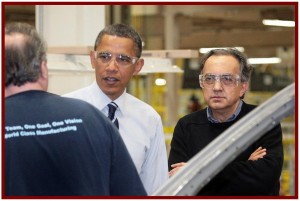Chrysler Group earned a profit of $183 million for the full year 2011, a turnaround from a net loss of $652 million in 2010. The positive, albeit small, result came as the Italian owned company paid back $551 million in debt to taxpayers last year and took control of 58.5% of the U.S. company. The UAW and CAW health care trusts controls the balance, and they wants out as soon as possible. Gross debt of Chrysler is now $12.5 billion, with $5.1 billion of that attributable to the notes held by the trusts.
Chrysler’s net revenue for the year was $55 billion, up 31% from a year ago. Fourth quarter net revenue increased at a greater rate, up 41% to $15.1 billion, the best quarter since Chrysler emerged from a controversial taxpayer-financed bankruptcy in 2009 under the Obama Administration. Global vehicle sales in 2011 totaled 1,855,000, up 22% from 2010; fourth quarter global sales were 479,000, up 28% compared with 2010.
Virtually all of the improvement was the direct result of Chrysler’s impressive U.S. sales performance. Market share increased to 10.5% during 2011, a gain of more than a full percentage point in a business where a couple of tenths matter and are closely fought over. The sales improvement was helped, in part, by the misfortune of Japanese automakers that were effectively out of the U.S. market for six months because of production disruptions caused by natural disasters. This boon likely will not repeat itself in 2012.
Nevertheless, the positive Chrysler Group growing sales trend is thus far continuing. Yesterday Chrysler Group reported January U.S. sales of 101,149, up 44% compared with sales in January 2011 of 70,118 vehicles. This was the 22nd consecutive month of year-over-year sales gains and the eighth consecutive month of sales increases of at least 20%. The C in Chrysler now clearly represents a Comeback Chrysler car company.
The renewed customer interest in the Fiat-owned company – whose survival seems assured, at least for the near term – resulted in the large sales increases of trucks, Jeeps and minivans. (See Chrysler Group January 2012 U.S. Sales Rise 44%)
“The house is in good shape,” said Sergio Marchionne CEO of both Chrysler and owner Fiat. “We are financially sound. We are in an incredibly strong position. The order book continues to build.”
In spite of Marchionne’s enthusiasm, the debate about Chrysler’s future is centered on large, tough financial and product development issues: Can Chrysler continue to grow in the U.S. at current rates, which is needed to generate the cash necessary to revive its less than competitive product line, or will a now sagging parent Fiat milk the company of cash, as previous owner Mercedes-Benz did, thereby diminishing its future? Marchionne likened that prospect, which he dismissed, to an “unhappy marriage,” during a conference call with reporters. Nonetheless, the Eurozone remains a crisis zone, and Italy where Fiat is headquartered and controls almost 30% of the market is in danger of a complete collapse.
In spite of ongoing economic uncertainty in the U.S. and Europe, Marchionne boldly predicted that Chrysler revenues would increase to $65 billion in 2012, an 18% increase. Earnings of $1.5 billion are predicted this year, with a free cash flow of more than $1 billion.
Another looming survival issue is Fiat’s lack of a serious presence in Asia, where half of the world’s population resides, and now with roughly one-third of global auto sales, trending to 50% in the near term. It looks like Marchionne needs another acquisition or alliance that makes it a force in Asia to able to compete with far larger automakers.


